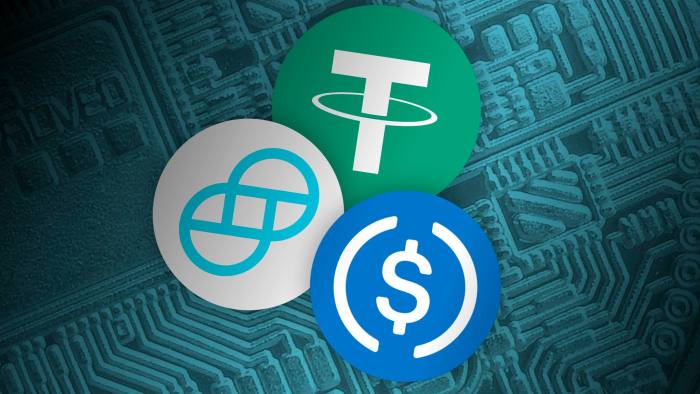#regulators #stablecoins #Fed #stability #DeFi #USD #money #ETH
“Stablecoin pseudonymity is Key to decentralized finance. DeFi tools are automated smart contracts running on Ethereum, Binance Smart Chain or Tron that provide various financial services such as banking, lending or trading”— Paul Ebeling
There are 2 types of financial regulations: anti-money laundering rules and financial stability rules.
Under the 1st, financial institutions like stablecoins are required to do due diligence on their customers to screen out bad actors.
The Big Q: Does the stablecoin hold sufficiently safe assets to ensure that it is actually stable?
The concerns over stablecoins relate to the 2nd type of regulation, financial stability.
“We have a tradition in this country where the public’s money is held in what is supposed to be a very safe asset,” Fed Chairman Powell said last wk, pointing to regulatory frameworks for bank deposits and money market funds, saying “That doesn’t exist for stablecoins.”
That lack of safety, combined with the market’s fast growth, has the Fed in a major quandary. Regulators fear this fast-growing segment of the financial industry.
But, the growth of stablecoins has been caused by the regulators themselves. More specifically, it is the regulators’ early failure to properly enunciate how anti-money laundering rules apply to stablecoins that has underpinned the market’s growth.
For yrs stablecoins have been providing a financial service that is in high demand, but no other US financial institution is allowed to provide: non-KYC’d, know your customer, access to digital USDs.
People can hold money in a PayPal account or a bank like Wells Fargo, but only after having passed through these institutions’ due diligence processes.
That is not the case with stablecoins.
A person can hold $100-K worth of tether or USD Coin without having to provide any identifying information whatsoever to either Tether or Circle, the owners of those stablecoin platforms.
That holder can then send the $100-K along to other users, who can transfer the stablecoins on, who in turn can transfer them on, and no 1 along the chain needs to go through a know-your-customer process.
The only users who stablecoin issuers identify are those who want to convert stablecoins back into USDs or those who want to deposit USDs at the stablecoin issuer in return for stablecoins. But that constitutes a very small minority of stablecoin users.
Given how anti-money laundering requirements have been getting more stringent for decades, 1 wonders why stablecoin issuers have been allowed to continue providing this level of pseudonymity. Not 1 US regulator has done anything to stop it.
There have been hints about dissatisfaction with stablecoin pseudonymity.
Last December, the President’s Working Group suggested that stablecoins should “have the capability to obtain and verify the identity of all transacting parties, including for those using unhosted wallets.”
A hosted stablecoin wallet refers to 1’s balances of tether or USD Coin held on an exchange like Coinbase, which does KYC on all of its customers.
An unhosted stablecoin wallet is when a user self-custodies their stablecoin balances. For the most part, stablecoins currently make no effort to identify un-hosted users.
The Office of the Comptroller of the Currency (OCC), 1 of America’s top banking regulators last yr granted Federal banks the authority to support stablecoin transactions, but only if they involve hosted wallets.
But, because all the big stablecoin issuers allow oodles of un-hosted activity, OCC-regulated banks are off limits to them.
So, the Top regulators do not like pseudonymity. But, the stablecoin platforms continue to offer it.
Since last December the stablecoin market has grown by $110-B stablecoins in circulation, due in no small part to demand for digital dollar pseudonymity.
Stablecoin pseudonymity is Key to decentralized finance, or DeFi. DeFi tools are automated smart contracts running on Ethereum, Binance Smart Chain or Tron that provide various financial services such as banking, lending or trading.
The financial services being offered on DeFi are strictly regulated in the US.
However, the operators of these decentralized tools have mostly avoided chartering or licensing, usually after appealing to their anonymity, automated nature and lack of centralization. And except for a few instances such as EtherDelta, a decentralized exchange, regulators have not shut these tools down.
Gray Market financial institutions would not normally be granted access to accounts at US financial institutions. But the stablecoin pseudonymity loophole allows these DeFi tools to do that. Thus ingesting huge amounts of safe digital dollars.
Stablecoin pseudonymity is also handy for outright unlawful activities.
Ponzi schemes and high-yield income programs (HYIPs) would normally be prevented from accessing USD payments. They are illegal, and so banks cannot serve them. But there are many instances of Ponzis and HYIPs using stablecoins for pay-ins and payouts, thanks to stablecoin KYC light touch.
Had US regulators at the beginning required stablecoins to do KYC on all their users, then gray market DeFi tools would not be able to access stablecoins, nor would Ponzis and HYIP operators. DeFi would be much smaller than it is now. And stablecoins would never have grown to become a $110-B market.
Regulators let pseudonymity continue, and so stablecoins got big.
Now the regulators find themselves in their own quagmire. With the market becoming significant, they find themselves worrying about matters like systemic risk, financial interdependencies and cascading failures.
Chairman Powell is not happy with the state of stablecoin regulators, but it’s worth keeping in mind that the US issuers of stablecoins already operate under a financial regulatory framework.
The New York Department of Financial Services, or NYDFS, has authorized state trust companies to issue stablecoins.
3 stablecoins: Gemini Dollar, Paxos Standard and BUSD operate under the NYDFS’s regulatory framework.
Circle, the issuer of the USD Coin stablecoin, has taken a different path toward regulation. It has secured 44 state money transmitter licenses. This is the same regulatory route taken by PayPal and Western Union.
As long as stablecoins remained small, these niche regulatory frameworks were sufficient for guaranteeing stablecoin financial safety. But Tether and USDC are now bigger than many US banks and money market mutual funds, which are required to abide by stricter rules than money transmitters.
Complicating matters is that the DeFi ecosystem has grown up around the assumption of pseudonymous stablecoin access. By removing pseudonymity late in the game rather than at the outset, regulators will be imposing big changes on these decentralized tools, if they can.
Regulators are late, and worried about financial stability issues surrounding stablecoins, but figuring out the pseudonymity loophole will be a big part of their task. They may not succeed.
Have a prosperous week, Keep the Faith!









